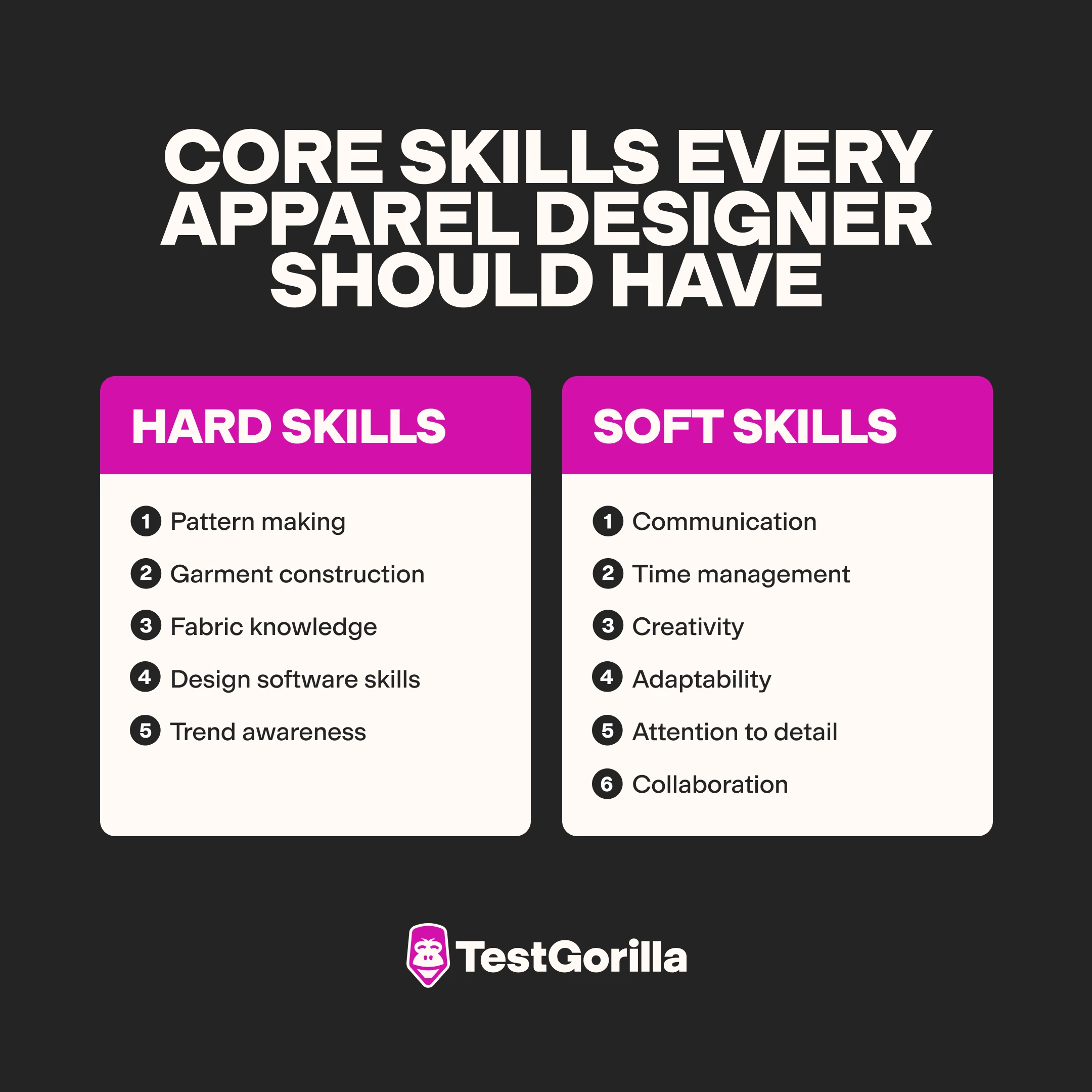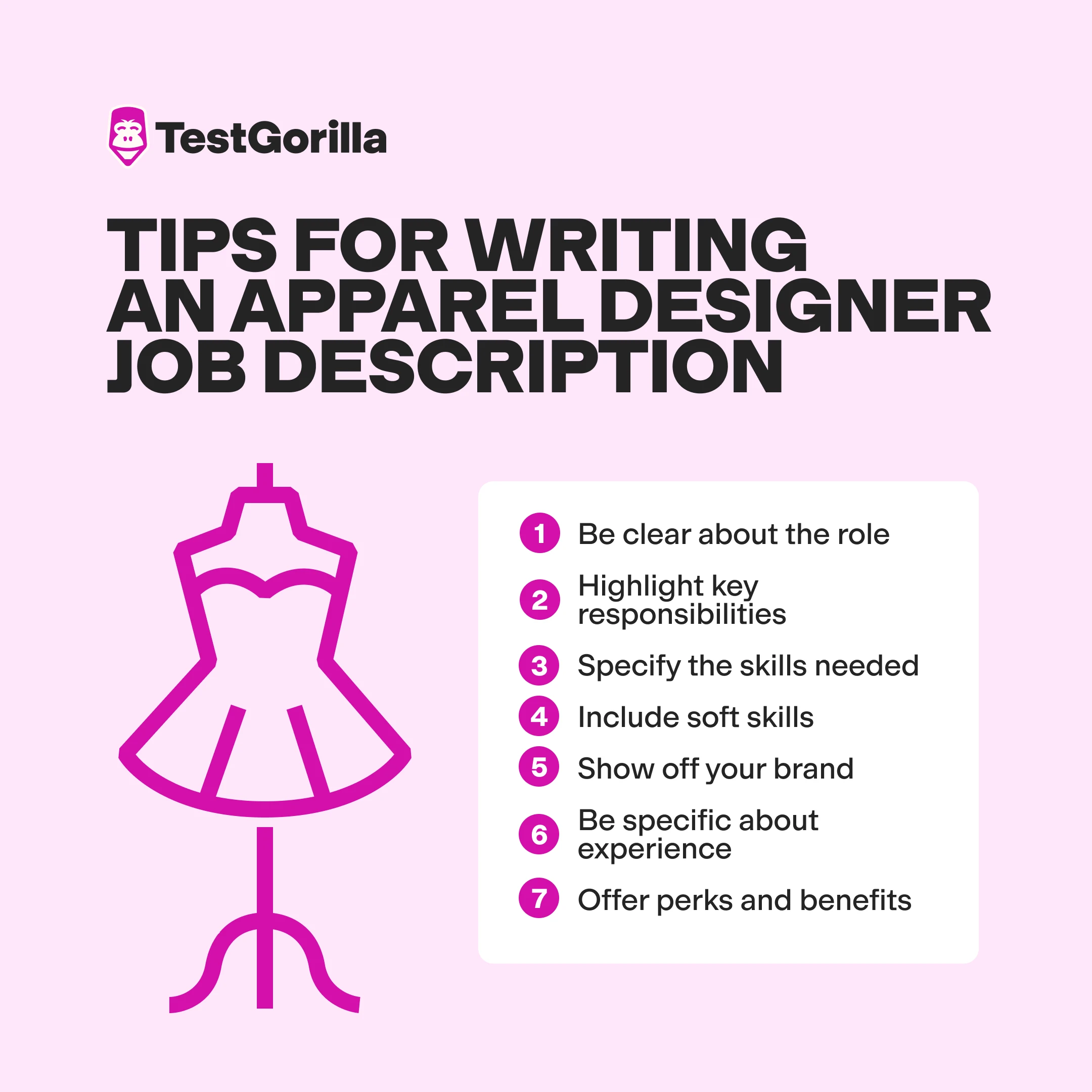There are plenty of apparel designers out there, but true gems who can transform your vision into wearable art are rare. And sifting through impressive resumes and portfolios to make sure you pick the right talent can be challenging.
An apparel designer with a fantastic resume but lackluster skills can quickly derail your brand. So, what key skills should you look for, and how can you make sure you're not hiring someone who’ll bring more harm than good? Don’t worry – we’ve got your back.
In this guide, we walk you through everything you should know about hiring an apparel designer – from the essential skills they need to foolproof tips you can use to assess and interview candidates. Keep reading to learn how to find the perfect apparel designer who’ll elevate your brand and make your vision a reality.
Table of contents
- What is an apparel designer?
- 11 skills to look for when hiring an apparel designer
- How to test your future apparel designer’s skills
- Top interview questions for an apparel designer
- Tips for writing an apparel designer job description
- Where to find an apparel designer for your business
- 3 common mistakes to avoid when hiring apparel designers
- FAQs
- Hire the best apparel designer with TestGorilla
What is an apparel designer?
American fashion and apparel designer and creator of DKNY, Donna Karan, once said, “Design is a constant challenge to balance comfort with luxury, the practical with the desirable.”
An apparel designer is the genius behind your favorite everyday clothes. They make sure they’re stylish, comfy, and practical. Unlike fashion designers who chase high-end trends, apparel designers prioritize comfort, functionality, and durability.
Apparel designers should have a portfolio packed with a range of designs – from casual to activewear – that shows off their ability to create pieces people actually want to wear.
Apparel designers also have a strong background in garment construction and fabric knowledge. They should typically be experts in design software, pattern making, and sewing techniques.
They often collaborate with pattern makers, seamstresses, and production managers to bring their designs to life. Plus, they work with marketing teams to make sure their designs line up with your brand's vision and customer needs.
11 skills to look for when hiring an apparel designer
Finding the right apparel designer can make or break your brand. Here’s a checklist of must-have skills to look for when shortlisting candidates.
Hard skills
An apparel designer needs more than just an eye for style. They need the technical chops to bring their ideas to life. Here are the hard skills to watch for:
Pattern making: A great apparel designer can create precise patterns that are the blueprint for any garment. They should be able to translate their designs into detailed patterns your production team can easily follow.
Garment construction: Knowing how to put together garments is key. This process includes various sewing techniques and finishing touches. A solid designer can visualize the final product and knows how to piece it all together.
Fabric knowledge: Understanding different fabrics and materials is a must. Your designer should know how various textiles behave and pick the right ones for each design – so the end product is both durable and comfortable.
Design software skills: Being skilled in design software like Adobe Illustrator, Photoshop, and CAD programs is essential. These tools help them create detailed designs and specs your production team can use without a hitch.
Trend awareness: Your designer should always know what’s trending. This helps them create designs that are fresh and keep your brand in the loop.
Soft skills
Don’t forget these important soft skills that make an apparel designer truly great:
Communication: With clear communication, design concepts are understood by everyone. Your designer should be able to explain their ideas and give detailed feedback.
Time management: Balancing multiple projects and meeting deadlines without compromising quality is a critical skill. A designer who manages time well keeps your schedule on track.
Creativity: Creativity is the core of design. You want someone who can consistently come up with unique ideas.
Adaptability: The apparel industry moves fast. An adaptable designer can handle unexpected changes and trends with ease.
Attention to detail: Noticing little details makes all the difference in apparel design – from choosing fabrics to crafting the smallest stitch.
Collaboration: Designing apparel is a team effort. Your designer should be a team player who works well with pattern makers, seamstresses, and marketing teams to bring their visions to life.
How to test your future apparel designer’s skills
A stellar resume might catch your eye, but you need to see your apparel designer’s skills in action to make sure they can deliver the designs you need. However, assessing their skills can be tricky and time-consuming.
This is where a talent discovery platform TestGorilla comes to the rescue. With our skills tests, you can efficiently evaluate your candidates’ capabilities. Here are some tests you might use:
Design-specific software tests: You can check your candidates’ digital design skills with tests like our Adobe Photoshop for Designers test, Adobe InDesign test, and AutoCAD test.
Problem Solving test: This test shows you how they come with solutions through reasoning. When design challenges come up, you need creative problem-solvers on your team.
Attention to Detail (Visual) test: This checks their attention to visual detail. You want someone who notices every tiny element and makes sure each design is perfect – right down to the last stitch.
Time Management test: Assess how they juggle tasks and deadlines. The apparel world is fast-paced, so your designer needs to stay on top of their schedule without compromising quality.
Communication Skills test: This test sees how well your candidates can communicate clearly, effectively, and professionally. Communication skills come in handy when they’re communicating with different parts of your team – manufacturers, clients, and more.
You can also use language skills assessments – like our English (Intermediate/B1) test – to make sure they can handle advanced professional conversations in specific languages.
Personality assessments: Tests like the Enneagram Test and 16 Personalities test help you understand their personality traits and behaviors to see how they’ll mesh with your team.
Portfolio review: Check out their past work for variety, precision, and more – and see how well their previous designs match your brand’s style.
You can create a custom assessment by combining up to five of the above tests. Add your own questions to each test to make the assessment even more unique to your role.
Top interview questions for an apparel designer
Another method you can use to assess your apparel designer is interviews. Here are four key questions to help you find the perfect fit for your brand:
“Describe a challenging apparel project you worked on. How did you overcome the obstacles?” Your candidates’ answers to this question can reveal their problem-solving skills and ability to handle setbacks, which are crucial in the fast-paced world of apparel design.
“How do you ensure the practicality and functionality of your designs while maintaining style?” This question digs into their ability to balance aesthetics with wearability, which is key for creating successful everyday apparel.
“How do you approach fabric selection for a new design?” Understanding their thought process behind fabric selection gives you insight into their knowledge of materials and how they impact the final product.
“What strategies do you use to make sure your designs are cost-effective while maintaining quality?” This question is crucial for understanding how they balance budget constraints with the need for high-quality, appealing designs.
Tips for writing an apparel designer job description
Hiring the right apparel designer can be a game-changer for your brand, so nailing the job description is a must. Here’s how to write one that attracts the perfect candidate.
1. Be clear about the role
Make it clear that you're looking for an apparel designer – not a fashion designer. Emphasize the practical, wearable aspects of the job.
2. Highlight key responsibilities
List out the main tasks they'll be handling. These might include:
Creating detailed technical drawings and patterns
Selecting fabrics and materials
Collaborating with production teams to make sure designs are feasible and high-quality
Staying updated on market trends to keep designs fresh and relevant
3. Specify the skills needed
Be specific about the skills your ideal candidate should have. These could include:
Strong knowledge of garment construction and sewing techniques
Proficiency in design software like Adobe Illustrator, Photoshop, and CAD
Excellent fabric knowledge to choose the best materials for each design
Attention to detail and an eye for quality
4. Include soft skills
Don’t forget to mention soft skills that are important for the role, including:
Creativity and innovation to keep your designs ahead of the curve
Strong communication skills to work effectively with the team
Good time management to handle multiple projects and meet deadlines
Flexibility to adapt to changing trends and feedback
5. Show off your brand
Give a brief overview of your company and what makes it unique. Let candidates know what they’ll be a part of and why they’ll love working with you. Highlight your brand’s style and vision to attract designers who line up with your values.
6. Be specific about experience
State the level of experience you’re looking for. Whether you need someone fresh out of design school or a seasoned pro, make it clear. Mention if you require experience in specific areas like activewear, casual wear, or workwear.
7. Offer perks and benefits
Finally, don’t forget to mention what’s in it for them. Whether it’s a work environment with tons of creative freedom, access to the latest design technology and resources, or participation in amazing team events and industry exhibitions, let them know why they’ll love working with you.
Where to find an apparel designer for your business
If you’re specifically looking for apparel designers, here are some tailored places to start your search:
Job boards: Websites like StyleCareers and FashionJobs cater specifically to the fashion industry, including apparel design roles. You’ll find candidates with the exact skills you need.
Hiring remotely? Use TestGorilla’s job board! You can invite candidates to take your assessment as the first step of the application process – so you can quickly find candidates with the skills you need.
Design schools: Connect with top design schools like Parsons School of Design and the Savannah College of Art and Design. They often have job boards and alumni networks where you can post openings and find recent graduates.
Professional apparel associations: Join organizations like the American Apparel & Footwear Association (AAFA) or the International Textile and Apparel Association (ITAA). They offer networking opportunities and access to a pool of industry professionals.
Freelance platforms for fashion: Use sites like Upwork and Freelancer, filtering for apparel design. You can find freelance apparel designers who specialize in creating practical, wearable clothing.
Apparel-specific social media pages: Instagram and LinkedIn are great places to find apparel designers. Use hashtags like #appareldesigner, #garmentdesigner, and #fashiontech to discover professionals showcasing their portfolios.
Recruitment agencies for apparel: Agencies like Fourth Floor can help you find apparel designers with the right experience and skills.
3 common mistakes to avoid when hiring apparel designers
Avoid these common mistakes and you’ll land yourself an excellent apparel designer:
1. Skipping the technical skills check
Apparel designers need to know how to make clothes – not just draw them. If they don’t understand garment construction and pattern making, their designs might look good on paper but fall apart in production.
For example, a designer might sketch a killer jacket but have no idea how to sew it together properly. Always ask about their technical skills and maybe even give them a small project to see if they can walk the talk.
2. Ignoring practicality
Apparel designers need to create clothes that people can actually wear. If they’re only focused on making things look cool, you might end up with designs that are uncomfortable or impractical.
Ask candidates how they balance style with functionality. Have them show you examples of their work that aren’t just pretty but also wearable and practical.
3. Not checking fit and sizing experience
Getting the fit right is crucial. If a designer doesn’t know how to size and grade their designs, you might end up with clothes that don’t fit anyone properly.
For instance, a designer might make awesome jeans that look great on the hanger but fit terribly. Make sure they understand fit and sizing, and ask about their process for making sure everything fits just right.
FAQs
Here are a couple commonly asked questions about apparel designers – plus answers.
What’s the difference between fashion design and apparel design?
Fashion design is about creating trendy, original clothing for high-end brands and fashion shows. It's artistic and innovative. Apparel design focuses on practical, everyday wear that’s comfortable and durable – usually for mass-market brands.
This might interest you: Read all about how to hire a fashion designer.
How does someone become an apparel designer?
Apparel designers typically get a degree in fashion design or a similar field, although it's not always necessary – especially if they develop the necessary skills in other ways. They get key skills in sketching, sewing, and design software, plus gain experience through internships or entry-level roles in the industry. Building a strong portfolio and networking are also important steps to success in this career.
Hire the best apparel designer with TestGorilla
With the right hiring approach, you can find a true creative gem when searching for an apparel designer. Once you know which skills to look for, the basics of crafting a standout job description, and effective assessment methods, you’re halfway there.
Just remember to be thorough when assessing your candidates. Don’t ignore their technical skills, practicality, and experience with fit and sizing.
Check out TestGorilla’s test library to revamp your hiring process and find the perfect candidate today. Need more help? Book a demo, or sign up for a free account.
Related posts
You've scrolled this far
Why not try TestGorilla for free, and see what happens when you put skills first.
Latest posts
The best advice on pre-employment testing, in your inbox.
No spam. Unsubscribe at any time.

Hire the best. No bias. No stress.
Our screening tests identify the best candidates and make your hiring decisions faster, easier, and bias-free.
Free resources
This checklist covers key features you should look for when choosing a skills testing platform
This resource will help you develop an onboarding checklist for new hires.
How to assess your candidates' attention to detail.
Learn how to get human resources certified through HRCI or SHRM.
Learn how you can improve the level of talent at your company.
Learn how CapitalT reduced hiring bias with online skills assessments.
Learn how to make the resume process more efficient and more effective.
Improve your hiring strategy with these 7 critical recruitment metrics.
Learn how Sukhi decreased time spent reviewing resumes by 83%!
Hire more efficiently with these hacks that 99% of recruiters aren't using.
Make a business case for diversity and inclusion initiatives with this data.



















